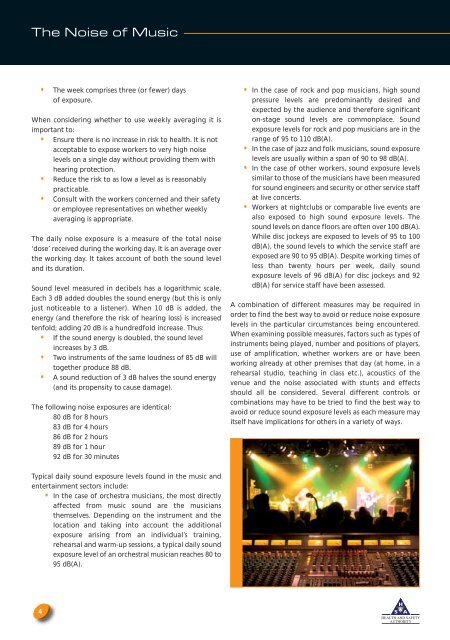The Noise of Music.pdf - Health and Safety Authority
The Noise of Music.pdf - Health and Safety Authority
The Noise of Music.pdf - Health and Safety Authority
Create successful ePaper yourself
Turn your PDF publications into a flip-book with our unique Google optimized e-Paper software.
<strong>The</strong> <strong>Noise</strong> <strong>of</strong> <strong>Music</strong><br />
• <strong>The</strong> week comprises three (or fewer) days<br />
<strong>of</strong> exposure.<br />
When considering whether to use weekly averaging it is<br />
important to:<br />
• Ensure there is no increase in risk to health. It is not<br />
acceptable to expose workers to very high noise<br />
levels on a single day without providing them with<br />
hearing protection.<br />
• Reduce the risk to as low a level as is reasonably<br />
practicable.<br />
• Consult with the workers concerned <strong>and</strong> their safety<br />
or employee representatives on whether weekly<br />
averaging is appropriate.<br />
<strong>The</strong> daily noise exposure is a measure <strong>of</strong> the total noise<br />
‘dose’ received during the working day. It is an average over<br />
the working day. It takes account <strong>of</strong> both the sound level<br />
<strong>and</strong> its duration.<br />
Sound level measured in decibels has a logarithmic scale.<br />
Each 3 dB added doubles the sound energy (but this is only<br />
just noticeable to a listener). When 10 dB is added, the<br />
energy (<strong>and</strong> therefore the risk <strong>of</strong> hearing loss) is increased<br />
tenfold; adding 20 dB is a hundredfold increase. Thus:<br />
• If the sound energy is doubled, the sound level<br />
increases by 3 dB.<br />
• Two instruments <strong>of</strong> the same loudness <strong>of</strong> 85 dB will<br />
together produce 88 dB.<br />
• A sound reduction <strong>of</strong> 3 dB halves the sound energy<br />
(<strong>and</strong> its propensity to cause damage).<br />
<strong>The</strong> following noise exposures are identical:<br />
80 dB for 8 hours<br />
83 dB for 4 hours<br />
86 dB for 2 hours<br />
89 dB for 1 hour<br />
92 dB for 30 minutes<br />
• In the case <strong>of</strong> rock <strong>and</strong> pop musicians, high sound<br />
pressure levels are predominantly desired <strong>and</strong><br />
expected by the audience <strong>and</strong> therefore significant<br />
on-stage sound levels are commonplace. Sound<br />
exposure levels for rock <strong>and</strong> pop musicians are in the<br />
range <strong>of</strong> 95 to 110 dB(A).<br />
• In the case <strong>of</strong> jazz <strong>and</strong> folk musicians, sound exposure<br />
levels are usually within a span <strong>of</strong> 90 to 98 dB(A).<br />
• In the case <strong>of</strong> other workers, sound exposure levels<br />
similar to those <strong>of</strong> the musicians have been measured<br />
for sound engineers <strong>and</strong> security or other service staff<br />
at live concerts.<br />
• Workers at nightclubs or comparable live events are<br />
also exposed to high sound exposure levels. <strong>The</strong><br />
sound levels on dance floors are <strong>of</strong>ten over 100 dB(A).<br />
While disc jockeys are exposed to levels <strong>of</strong> 95 to 100<br />
dB(A), the sound levels to which the service staff are<br />
exposed are 90 to 95 dB(A). Despite working times <strong>of</strong><br />
less than twenty hours per week, daily sound<br />
exposure levels <strong>of</strong> 96 dB(A) for disc jockeys <strong>and</strong> 92<br />
dB(A) for service staff have been assessed.<br />
A combination <strong>of</strong> different measures may be required in<br />
order to find the best way to avoid or reduce noise exposure<br />
levels in the particular circumstances being encountered.<br />
When examining possible measures, factors such as types <strong>of</strong><br />
instruments being played, number <strong>and</strong> positions <strong>of</strong> players,<br />
use <strong>of</strong> amplification, whether workers are or have been<br />
working already at other premises that day (at home, in a<br />
rehearsal studio, teaching in class etc.), acoustics <strong>of</strong> the<br />
venue <strong>and</strong> the noise associated with stunts <strong>and</strong> effects<br />
should all be considered. Several different controls or<br />
combinations may have to be tried to find the best way to<br />
avoid or reduce sound exposure levels as each measure may<br />
itself have implications for others in a variety <strong>of</strong> ways.<br />
Typical daily sound exposure levels found in the music <strong>and</strong><br />
entertainment sectors include:<br />
• In the case <strong>of</strong> orchestra musicians, the most directly<br />
affected from music sound are the musicians<br />
themselves. Depending on the instrument <strong>and</strong> the<br />
location <strong>and</strong> taking into account the additional<br />
exposure arising from an individual’s training,<br />
rehearsal <strong>and</strong> warm-up sessions, a typical daily sound<br />
exposure level <strong>of</strong> an orchestral musician reaches 80 to<br />
95 dB(A).<br />
4

















